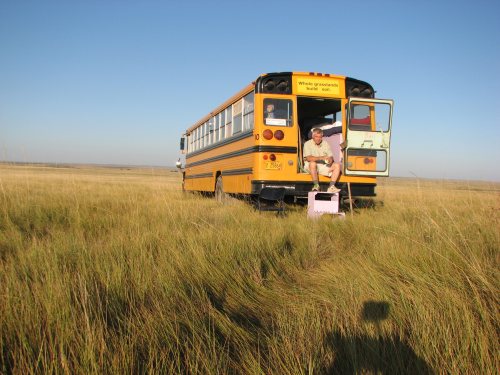Viewing posts from September, 2011
NRCS soil health factsheets--Farming in the 21st century
Posted by Peter Donovan 13 years, 10 months agoDiversity in the Dakotas
Posted by Peter Donovan 13 years, 10 months ago |
Sept 2011 update
Posted by Peter Donovan 13 years, 10 months ago<p>It has been a busy summer. I have moved into a school bus, and departed on a cross-country <a href="/challenge">Soil Carbon Challenge</a> baseline tour. The Challenge is a competition to showcase land managers who can turn atmospheric carbon into water-holding, fertility-enhancing soil organic matter.</p><p><img src="/files/images/busingrassland.jpg" alt="school bus in grassland" width="300" height="225" /> <em>In South Dakota.</em> <img src="/files/images/dungbeetles.jpg" alt="dung beetles" width="300" height="204" /> <em>Biodiversity doesn't just sit there. IT DOES THE WORK. Dung beetles at work on a Grasslands/Savory Institute ranch in South Dakota.</em></p><p>After some difficulties with the website during this transition, it is now up and fully functional. See the recent <a href="/diversity-dakotas">update</a> on the Challenge baseline tour, which concludes with an approximate itinerary for the rest of September.</p><p>If you want to help change the way we think about the carbon and water cycles, and the opportunities for enhancing these, please consider the following options:</p><p>1. Enter the Challenge. In North America, we can do replicable baselines for under a thousand dollars, depending on location and timing. Everything we do is open source, and Peter is happy to show others the practical, accurate, and replicable <a href="/files/MeasuringSoilCarbonChange.pdf">monitoring method.</a></p><p>2. Partner with us. Are you an organization, group, municipal government, park and recreation district, or water district with an interest in conservation, sustainable land management, and recognizing <a href="http://www.fastcompany.com/node/42075/print">positive deviants</a> (those who are successful beyond the norm)? Help us connect to people who have achieved or are likely to achieve above-average results in building soil carbon, and want to succeed at it. We can help monitor what land managers in your area are achieving.</p><p>3. Make a donation. If you would like to help support a Challenge or monitoring project in a specific area, a specific sector, or even with a specific land manager, we will gladly help you do this. With a clearly delimited project, you can get an accounting, in tons, of the atmospheric carbon that is turned into water-holding, fertility-enhancing soil carbon. You can start your own localized Soil Carbon Challenge!</p><p><a href="/html/changemap.htm"><img src="/files/images/mapscreenshot.jpg" width="295" /></a>Our map of soil carbon change is becoming a diverse, site-specific answer to the question, how can we increase soil carbon? Can you help us fill this map? Click on the map to explore it on the web.</p><p>4. Ask Peter or one of our <a href="/about">board members</a> or associates to address a group in your area. For example, Peter does the following facilitated workshop, either half or full day:</p><p><b>Discovering the carbon cycle</b></p><p>Most of what we hear about carbon, and the global carbon cycle, is threatening and negative. It is a bad situation, and we do not seem to have much power or leverage over it.</p><p>All of our environmental and economic issues depend on the ways carbon and water move, on every scale from the square foot of soil surface to the entire globe. Human decisions have an enormous influence on the way these cycles function. And underlying human decisions are our beliefs, often based on past experience and training.</p><p>Peter Donovan has been establishing soil carbon baseline measurements on progressive and innovative ranches and farms in the west, and is currently traveling eastward doing the same. He will tell the fascinating and little-known story of the discovery of the carbon cycle, its relation to water, describe what some of these innovative ranchers and farmers are doing to enhance these functions, and facilitate a discussion on ways to take advantage of these enormous opportunities.</p>
Recent Posts
Archive
Categories
- Events (2)
- policy and framing (22)
- ruminations (3)
Tags
- atlas (2)
Authors
- Peter Donovan (135)
- Didi Pershouse (3)